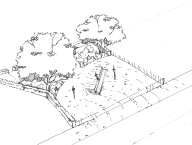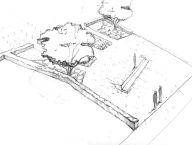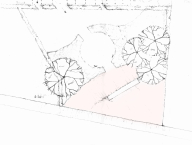Autorský tým: Ing. arch. Martin Augustin, Ing. Jindřich Vaněk, Ing. Lucie Pšikalová, Ing. Anna Veselá (Součková) a Ing. Kostyunicheva Yuliana
Pokud v roce 2022 navštívíme vojenské pohřebiště ve Vouziers, můžeme kromě pomníku československých legionářů z roku 1925 navštívit také Českou zahradu míru, stačí projít průchody vytvořenými v zeleném plotě.
Ocitneme se na rozkvetlé louce, která přechází v prostor posetý keřovými růžemi. Průhledy mezi jednotlivými keři naznačují pokračování zahrady. Vstoupíme-li do komponovaného vchodu přímým směrem, ocitneme se v kruhovém prostoru lemovaném vyššími keři růží. Pokud nám prostor evokuje interiér centrální barokní kaple, nemýlíme se.
Na Pražském hradě, sídle českých králů, se nachází ideální vzor: kostel svatého Jana Nepomuckého od slavného barokního architekta Kiliána Ignáce Dientzenhofera. Tento kostel vyzdvihl pražský arcibiskup jako místo modliteb za padlé a zemřelé vojáky a za mír na celém světě. Stal se centrem společenství Křížové hřeby, které dnes působí na více než 150 místech světa a usiluje o smíření zmítané různými konflikty, a jeho prostor slouží jako místo setkávání.
Předchůdce pražského kostela svatého Jana Nepomuckého najdeme v nenápadné reminiscenci Vouznerovy zahrady, a to i při pohledu na stylizované kovové stély, půdorysně prohnuté, umístěné po obou stranách osového průchodu přírodní kaple. Stejně jako v konkávních barokních nikách v Praze můžeme i zde číst texty modliteb za padlé vojáky vlevo a za mír vpravo. V tomto případě jsou texty vytesány do rezavého ocelového plechu, v němž můžeme rozpoznat i stylizovaný kříž z hřebů. Plocha kruhového prostoru s možností posezení je zde pokryta kopretinami (Bellis perenis) evokujícími lehkou plochou dlažbu. Tato iluzorní podlaha je opatřena dlaždicí s nápisem nápisem CARO BONO PATRI MEO, jehož motto stejně jako v Praze vyjadřuje úctu k předkům, na jejichž odkaz navazujeme. Pokud nás zaujme procházka mezi růžemi, zjistíme, že procházíme labyrintem keřů z různých druhů planých růží a šípků. Můžeme si všimnout, že pyramidy z červených růží pokrývají z armovací oceli. To spolu s trním evokuje pěchotní zátarasy na bojištích, které však síla přírody mírumilovně překonala, protože život si znovu nachází své místo a vždy vítězí nad smrtí. I my překonáme toto pole růží a otevře se před námi osvobozující pohled do volné krajiny, zdůrazněný terénní modelací jediné terasy (princip ha-ha). Svislá stěna terasy je hrubě opracovaná z kamene a ze stejného materiálu je i plocha prezentovaná před ní. Jedinečná geometrie dává smysl teprve tehdy, když sejdeme dolů a otočíme se zpět, protože teprve tehdy rozpoznáme negativní horizontální otisk obelisku před námi a odhalíme celý jeho příběh.
Tomáš Garrigue Masaryk se stal prvním prezidentem Československa po první světové válce. Během války, kdy byl v exilu, organizoval vznik československých legií. Není náhodou, že škola Lycee Tomáše Masaryka se dnes nachází ve Vouziers, kde se vyznamenaly 21. a 22. pluk československých legií. Tomáš Garrigue Masaryk po svém nástupu do funkce toužil náležitě uctít památku obětí první světové války. Architekt Plečnik za tímto účelem navrhl na Pražském hradě monumentální obelisk, který měří na výšku 15,7 m a byl slavnostně vztyčen u příležitosti desátého výročí vzniku Československa 28. října 1928 na III. nádvoří Pražského hradu. Ve stejné době vznikly i další pomníky legionářů. U Emauzského kláštera v Praze nese pomník mimo jiné nápisy Terron, Champagne a Vouziers. Celá kompozice působí dobře i v opačném pohledu. Dominuje jí kontrastní světlý horizontální otisk obelisku. Je umístěn na květnaté louce s mákem (Papaver rhoeas). Nad obeliskem je kompozice v pozadí doplněna pásem růží. Stávající dub je ponechán. Jako protiváha je na opačném okraji pozemku vysazena trojice lip srdčitých (Tilia cordata), českého národního stromu.
Kamenný monument obelisku byl ve skutečnosti vytěžen v lomu v České republice. Odhlédneme-li od fyzického původu kamene, zůstává tu jeho duchovní původ. Vše, co symbolizuje, bylo zaplaceno krví. V tomto přeneseném smyslu získali vítězný obelisk vojáci z bojišť. Symbolika místa, kde návštěvník najde v náznaku podlahy lomu negativní otisk obelisku obklopeného loukou s divokými květy máku, je spolu s přírodní kaplí ústředním motivem našeho návrhu Zahrady míru. Symbolické spojení vzdálené ciziny s domovem, do kterého se mnozí krajané nemohli vrátit.
Peace garden (France 2021)
Author team: Ing. arch. Martin Augustin, Ing. Jindřich Vaněk, Ing. Lucie Pšikalová, Ing. Anna Veselá (Součková) a Ing. Kostyunicheva Yuliana
If we visit the military burial ground in Vouziers in 2022, in addition to the monument to the Czechoslovak legionaries from 1925, we can also visit the Czech Peace Garden, just go through the passages created in the green fence.
We find ourselves in a flowering meadow, which turns into a space dotted with bush roses. The vistas between the individual shrubs suggest the continuation of the garden. If we enter the composed entrance in a direct direction, we find ourselves in a circular space lined with taller rose bushes. If the space evokes the interior of the central baroque chapel, we are not mistaken.
At the Prague castle, the seat of Bohemian Kings, there is an ideal pattern: a church of Saint John of Nepomuk built by the famous baroque architect Kilian Ignac Dientzenhofer. This church was singled out by the Archbishop of Prague as a place of prayer for fallen and dead soldiers and for peace around the world. It became a centre of the community of the Cross Nails, nowadays active in more than 150 places in the world and aims to bring reconciliation torn by various conflicts, and its space serves as a meeting place.
The forerunner of the Prague Church of St. John of Nepomuk can be found in the inconspicuous Vouzier garden reminiscence, even when looking at the stylized metal stelae curved in plan, placed on both sides of the axial passage of the natural chapel. As in the concave Baroque niches in Prague, we can read the texts of the prayer for the fallen
soldiers on the left and for peace on the right. In this case, the texts are carved in a rustcovered sheet of steel, where we can also recognize a stylized cross made of nails. The area of the circular space with a possibility of sitting here is covered by daisies (Bellis perenis) evoking light flat pavement. This illusory floor is fitted with a tile with the
inscription CARO BONO PATRI MEO, whose motto, as in Prague, expresses respect for the ancestors whose legacy we follow. If we are attracted to walking among the roses, we will find that we are walking through a labyrinth of bushes made of different kinds of wild roses and rosehips. We can notice that red roses cover the pyramids made of
the raw material of reinforcing steel. This, together with the thorn, evokes the infantry barriers of the battlefields, which, however, the power of nature has peacefully overcome, as life finds its place again and always overcomes death. We too will overcome this field of roses and a liberating view of an open free landscape will open before us, emphasized by the terrain modelling of a single terrace (ha-ha principle). The vertical wall of the terrace is roughly stone-worked and the surface presented in front of it is made of the same material. The unique geometry only makes sense when we go down and turn back, because only then do we recognize the negative horizontal imprint of the obelisk in front of us and reveal its whole story.
Tomáš Garrigue Masaryk became the first president of Czechoslovakia after the First World War. During the war when being in exile, he organized the formation of Czechoslovak legions. It is no coincidence that the Lycee Thomas Masaryk school is located today in Vouziers, where the 21st and 22nd Regiments of the Czechoslovak Legions were distinguished. After taking office, Tomáš Garrigue Masaryk longed to properly honour the memory of the victims of the First World War. Architect Plečnik designed a monumental obelisk at Prague Castle for this purpose, which measures 15.7 m in height and was ceremoniously erected on the occasion of the tenth anniversary of the founding of Czechoslovakia on October 28, 1928 at the III courtyard of Prague Castle. At the same time, other monuments to the legionnaires were created. At the Emmaus Monastery in Prague, the monument bears, among other things, the inscriptions Terron, Champagne and Vouziers. The whole composition works well in the opposite view. It is dominated by a contrasting light horizontal imprint of the obelisk. It is located in a flowery meadow containing poppy (Papaver rhoeas). Above the obelisk, the background composition is completed by a strip of roses. The existing oak is left. As a counterweight, a trio of lindens (Tilia cordata), the Czech national tree, are planted at the opposite edge of the plot.
In fact, the stone monument of the obelisk was mined in quarry in the Czech Republic. If we look away from the physical origin of the stone, there is still its spiritual origin. Everything it symbolizes was paid for with blood. In this figurative sense, the victorious obelisk was gained by soldiers from the battlefields. The symbolism of the place where the visitor finds in the hint of the quarry floor a negative imprint of the obelisk surrounded by a meadow with wild poppy flowers, together with the natural chapel, is the central motif of our design of the Garden of Peace. A symbolic connection between a distant foreign country and a home to which many compatriots could not return.







